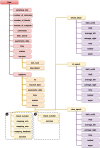Prefrontal Asymmetry BCI Neurofeedback Datasets
- PMID: 33390885
- PMCID: PMC7775574
- DOI: 10.3389/fnins.2020.601402
Prefrontal Asymmetry BCI Neurofeedback Datasets
Abstract
Prefrontal cortex (PFC) asymmetry is an important marker in affective neuroscience and has attracted significant interest, having been associated with studies of motivation, eating behavior, empathy, risk propensity, and clinical depression. The data presented in this paper are the result of three different experiments using PFC asymmetry neurofeedback (NF) as a Brain-Computer Interface (BCI) paradigm, rather than a therapeutic mechanism aiming at long-term effects, using functional near-infrared spectroscopy (fNIRS) which is known to be particularly well-suited to the study of PFC asymmetry and is less sensitive to artifacts. From an experimental perspective the BCI context brings more emphasis on individual subjects' baselines, successful and sustained activation during epochs, and minimal training. The subject pool is also drawn from the general population, with less bias toward specific behavioral patterns, and no inclusion of any patient data. We accompany our datasets with a detailed description of data formats, experiment and protocol designs, as well as analysis of the individualized metrics for definitions of success scores based on baseline thresholds as well as reference tasks. The work presented in this paper is the result of several experiments in the domain of BCI where participants are interacting with continuous visual feedback following a real-time NF paradigm, arising from our long-standing research in the field of affective computing. We offer the community access to our fNIRS datasets from these experiments. We specifically provide data drawn from our empirical studies in the field of affective interactions with computer-generated narratives as well as interfacing with algorithms, such as heuristic search, which all provide a mechanism to improve the ability of the participants to engage in active BCI due to their realistic visual feedback. Beyond providing details of the methodologies used where participants received real-time NF of left-asymmetric increase in activation in their dorsolateral prefrontal cortex (DLPFC), we re-establish the need for carefully designing protocols to ensure the benefits of NF paradigm in BCI are enhanced by the ability of the real-time visual feedback to adapt to the individual responses of the participants. Individualized feedback is paramount to the success of NF in BCIs.
Keywords: PFC asymmetry; dataset; functional near infrared spectroscopy (fNIRS); neurofeedback (NF); visual feedback (VF).
Copyright © 2020 Charles, De Castro Martins and Cavazza.
Conflict of interest statement
The authors declare that the research was conducted in the absence of any commercial or financial relationships that could be construed as a potential conflict of interest.
Figures












References
-
- Afergan D., Shibata T., Hincks S. W., Peck E. M., Yuksel B. F., Chang R., et al. (2014). “Brain-based target expansion,” in Proceedings of the 27th Annual ACM Symposium on User Interface Software and Technology (Honolulu, HI: ), 583–593. 10.1145/2642918.2647414 - DOI
-
- Aranyi G., Cavazza M., Charles F. (2015a). “Using fNIRS for prefrontal-asymmetry neurofeedback: methods and challenges,” in International Workshop on Symbiotic Interaction (Cham: Springer; ), 7–20. 10.1007/978-3-319-24917-9_2 - DOI
-
- Aranyi G., Charles F., Cavazza M. (2015b). “Anger-based BCI using fNIRS neurofeedback,” in Proceedings of the 28th Annual ACM Symposium on User Interface Software & Technology (Charlotte, NC: ), 511–521. 10.1145/2807442.2807447 - DOI
LinkOut - more resources
Full Text Sources
Miscellaneous

